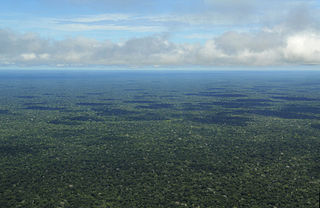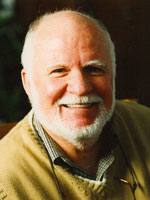
The Amazon rainforest, also called Amazon jungle or Amazonia, is a moist broadleaf tropical rainforest in the Amazon biome that covers most of the Amazon basin of South America. This basin encompasses 7,000,000 km2 (2,700,000 sq mi), of which 5,500,000 km2 (2,100,000 sq mi) are covered by the rainforest. This region includes territory belonging to nine nations and 3,344 formally acknowledged indigenous territories.

The Amazon basin is the part of South America drained by the Amazon River and its tributaries. The Amazon drainage basin covers an area of about 6,300,000 km2 (2,400,000 sq mi), or about 35.5 percent of the South American continent. It is located in the countries of Bolivia, Brazil, Colombia, Ecuador, Guyana, Peru, Suriname, and Venezuela, as well as the territory of French Guiana.
Carl Ortwin Sauer was an American geographer. Sauer was a professor of geography at the University of California at Berkeley from 1923 until becoming professor emeritus in 1957. He has been called "the dean of American historical geography" and he was instrumental in the early development of the geography graduate school at Berkeley. One of his best known works was Agricultural Origins and Dispersals (1952). In 1927, Carl Sauer wrote the article "Recent Developments in Cultural Geography," which considered how cultural landscapes are made up of "the forms superimposed on the physical landscape."

Terra preta is a type of very dark, fertile anthropogenic soil (anthrosol) found in the Amazon Basin. It is also known as "Amazonian dark earth" or "Indian black earth". In Portuguese its full name is terra preta do índio or terra preta de índio. Terra mulata is lighter or brownish in color.

Historical ecology is a research program that focuses on the interactions between humans and their environment over long-term periods of time, typically over the course of centuries. In order to carry out this work, historical ecologists synthesize long-series data collected by practitioners in diverse fields. Rather than concentrating on one specific event, historical ecology aims to study and understand this interaction across both time and space in order to gain a full understanding of its cumulative effects. Through this interplay, humans adapt to and shape the environment, continuously contributing to landscape transformation. Historical ecologists recognize that humans have had world-wide influences, impact landscape in dissimilar ways which increase or decrease species diversity, and that a holistic perspective is critical to be able to understand that system.

Cultural landscape is a term used in the fields of geography, ecology, and heritage studies, to describe a symbiosis of human activity and environment. As defined by the World Heritage Committee, it is the "cultural properties [that] represent the combined works of nature and of man" and falls into three main categories:
- "a landscape designed and created intentionally by man"
- an "organically evolved landscape" which may be a "relict landscape" or a "continuing landscape"
- an "associative cultural landscape" which may be valued because of the "religious, artistic or cultural associations of the natural element."

Cultural geography is a subfield within human geography. Though the first traces of the study of different nations and cultures on Earth can be dated back to ancient geographers such as Ptolemy or Strabo, cultural geography as academic study firstly emerged as an alternative to the environmental determinist theories of the early 20th century, which had believed that people and societies are controlled by the environment in which they develop. Rather than studying pre-determined regions based upon environmental classifications, cultural geography became interested in cultural landscapes. This was led by the "father of cultural geography" Carl O. Sauer of the University of California, Berkeley. As a result, cultural geography was long dominated by American writers.

The white-bearded hermit is a species of hummingbird in the family Trochilidae. It is found in Bolivia, Brazil, Colombia, Ecuador, Peru, and Venezuela.

The Llanos de Moxos, also known as the Beni savanna or Moxos plains, is a tropical savanna ecoregion of the Beni Department of northern Bolivia.

The Mojeños, also known as Moxeños, Moxos, or Mojos, are an indigenous people of Bolivia. They live in south central Beni Department, on both banks of the Mamore River, and on the marshy plains to its west, known as the Llanos de Mojos. The Mamore is a tributary to the Madeira River in northern Bolivia.

A natural landscape is the original landscape that exists before it is acted upon by human culture. The natural landscape and the cultural landscape are separate parts of the landscape. However, in the 21st century, landscapes that are totally untouched by human activity no longer exist, so that reference is sometimes now made to degrees of naturalness within a landscape.
Waru Waru is an Aymara term for the agricultural technique developed by pre-Hispanic people in the Andes region of South America from Ecuador to Bolivia; this regional agricultural technique is also referred to as camellones in Spanish. Functionally similar agricultural techniques have been developed in other parts of the world, all of which fall under the broad category of raised field agriculture.

William Balée is a professor of anthropology at Tulane University in New Orleans, Louisiana.

Billie Lee Turner II is an American geographer and human-environmental scientist, member of the National Academy of Sciences and other honorary institutions. Prominent among the third generation of the Berkeley School of Latin Americanist Geography and cultural ecological research, he has been a leader in bridging this work with the Chicago School of natural hazards and risk research. In August 2008, he took a position as the first Gilbert F. White Chair in Environment and Society at Arizona State University, where he is affiliated with the School of Geographical Sciences and Urban Planning and the School of Sustainability. In November 2015, he was named a Regent’s Professor, the highest faculty honor that can be bestowed by Arizona State University.
Prior to the European colonization of the Americas, indigenous peoples used fire to modify the landscape. This influence over the fire regime was part of the environmental cycles and maintenance of wildlife habitats that sustained the cultures and economies of the Indigenous peoples of the Americas. What was initially perceived by colonists as "untouched, pristine" wilderness in North America was the cumulative result of the Indigenous use of fire, creating an mosaic of grasslands and forests across North America, sustained and managed by the peoples indigenous to the landscape.

The Southwest Amazon moist forests (NT0166) is an ecoregion located in the Upper Amazon basin.
The Berkeley School of Latin Americanist Geography was founded by the American geographer Carl O. Sauer. Sauer was a professor of geography at the University of California at Berkeley from 1923 until becoming professor emeritus in 1957 and was instrumental in the early development of the geography graduate program at Berkeley and the discipline of geography in the United States. Each generation of this research school has pursued new theoretical and methodological approaches, but their study of the peoples and places of Latin America and the Caribbean has remained the common denominator since the early 20th century. Carl O. Sauer himself did not develop a particular interest in Latin America before 1925, when Oskar Schmieder, a German geographer, disciple of Alfred Hettner, and expert in Latin American regional geography, arrived at Berkeley, coming from Córdoba, Argentina, to work as an associate professor. Obviously, his interest awoke during Schmieder's presence between 1925 and 1930. After Schmieder's departure in 1930, Carl O. Sauer began to offer seminars on the regional geography of Latin America.

Herbert Wilhelmy was a German geographer. Wilhelmy has made significant impact in the area of Latin American regional geography, with a focus on climatic geomorphology and, especially, morphogenetic urban geography.

The Llanos de Moxos, also known as the Llanos de Mojos and the Beni Savanna, have extensive remains of pre-Columbian agricultural societies scattered over most of Beni Department, Bolivia. The remains testify to a well-organized and numerous indigenous people. This contradicts the traditional view of archaeologists, notably Betty Meggers, who asserted that the Amazon River Basin was not environmentally able to sustain a large population and that its indigenous inhabitants were hunter-gatherer bands or slash-and-burn farmers. In the 1960s, petroleum company geologists and geographer William Denevan were among the first to publicize the existence of extensive prehistoric earthworks constructed in the Amazon, especially in the Llanos de Moxos.

The environmental history of Latin America has become the focus of a number of scholars, starting in the later years of the twentieth century. But historians earlier than that recognized that the environment played a major role in the region's history. Environmental history more generally has developed as a specialized, yet broad and diverse field. According to one assessment of the field, scholars have mainly been concerned with "three categories of research: colonialism, capitalism, and conservation" and the analysis focuses on narratives of environmental decline. There are several currents within the field. One examines humans within particular ecosystems; another concerns humans’ cultural relationship with nature; and environmental politics and policy. General topics that scholars examine are forestry and deforestation; rural landscapes, especially agro-export industries and ranching; conservation of the environment through protected zones, such as parks and preserves; water issues including irrigation, drought, flooding and its control through dams, urban water supply, use, and waste water. The field often classifies research by geographically, temporally, and thematically. Much of the environmental history of Latin America focuses on the nineteenth and twentieth centuries, but there is a growing body of research on the first three centuries (1500-1800) of European impact. As the field established itself as a more defined academic pursuit, the journal Environmental History was founded in 1996, as a joint venture of the Forest History Society and the American Society for Environmental History (ASEH). The Latin American and Caribbean Society for Environmental History (SOLCHA) formed in 2004. Standard reference works for Latin American now include a section on environmental history.















